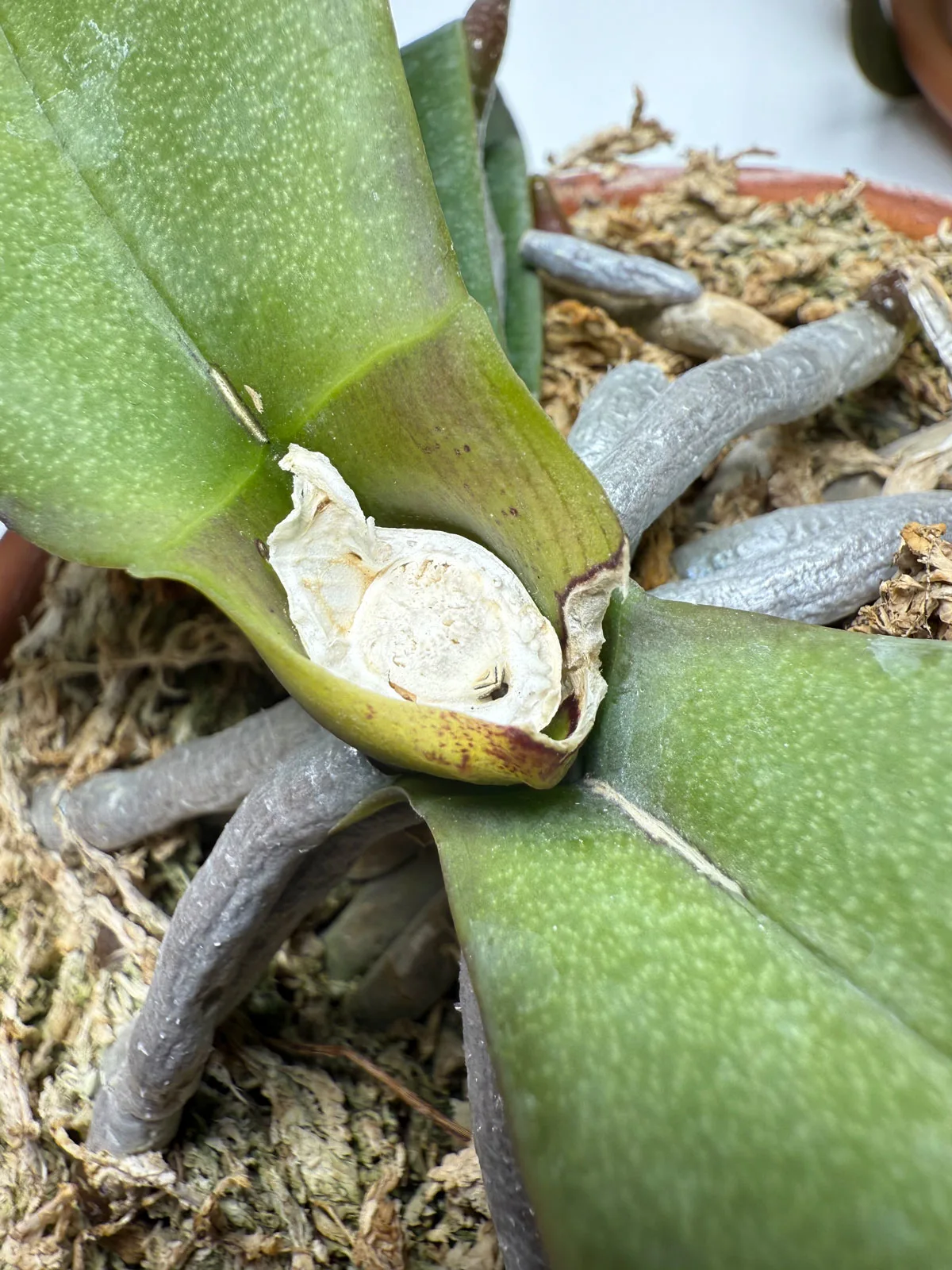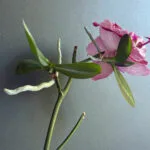Some of the links in this post may be affiliate links.
Do you have a moth orchid that has a damaged crown? Don’t throw it away because it doesn’t necessarily mean that it is dead! With a little patience, your plant can continue to live. Keep reading to see exactly how.

Saving an Orchid That Lost Its Growing Tip
If your Phalaenopsis orchid has lost its growing tip (either from physical damage or even from crown rot), your orchid can still be salvageable! Before I show you how your plant can regenerate itself, let’s address crown rot first.
The crown of the orchid is simply the center of the plant. If your crown starts to rot, it can be deadly for the plant. (Crown rot is usually caused by sitting water in the center of the plant.) If you notice that the center of your Phalaenopsis is rotting, remove any rotting leaves and pour some hydrogen peroxide right in the center of the plant in order to disinfect it. The peroxide may fizz a bit, and that is totally normal. After a couple minutes, tip the plant over to remove any accumulated hydrogen peroxide, and keep the crown dry from now on.
Take a look at the photo of the orchid below. This is an orchid that I rescued and it was given to me this way.

I’m not certain if there was physical damage in the crown, or if the crown started to rot, but whatever caused it, the growing tip is gone. The center of the plant has dried out, and at this point, the only thing you need to do is provide regular care for your orchid.
As long as your plant hasn’t completely rotted out, there is hope! Once the growing tip is damaged in a Phalaenopsis orchid, it should start to grow what is called a basal keiki. (That is, as long as the rot hasn’t destroyed the buds at the base of the plant from which the keiki would grow from.) A basal keiki is simply a small orchid plant that starts to grow right at the base of the plant.
Once a moth orchid loses its growing tip, the plant redistributes hormones and causes a new plant, a basal keiki, to grow at the base of the plant just like I show in the photo of my plant below. (This is similar to what happens if you pinch the growing tips of your summer annuals. It will result in the plants branching out and activating growth in dormant buds.)
Take a look at the basal keiki emerging from the plant.

At first, when the basal keiki started to grow, it almost looked like a robust flower spike growing, but as it continued to grow, it was apparent that a keiki was growing!
Three weeks later, you can see how big the basal keiki is getting.

And here is a closer look so that you can see how it attaches onto the base of the plant.

Basal keikis will grow at the base of some Phalaenopsis plants even if the growing tip isn’t damaged, so even if you have a healthy plant, this is something that you may eventually see on some of your moth orchid plants.
Even if your plant has lost all of its leaves, as long as your root system looks healthy, hang onto your plant and it may still form a basal keiki!
As your basal keiki continues to grow, you can leave it on the original plant, or if you are feeling adventurous, you can try cutting it off of the mother plant and pot it up when it is big enough and has some roots of its own.
Phalaenopsis orchids can also grow keikis on old flower stalks that are still green and alive. Take a look at the keiki growing on an old flower spike of one of my plants.

You can also have keikis growing on flower spikes. Phalaenopsis orchids are quite resilient!
If you want to learn all about how to get your orchid to rebloom reliably and have healthy, thriving moth orchid plants, don’t miss my signature, online orchid care course, Become an Orchid Master. It also includes bonuses with support from me, personally, to guide you in your orchid journey!







Susan Badertscher
Monday 9th of June 2025
I received an orchid that was in trouble and now it has lost all leaves and the blossom stalk has lost all blooms and is slowly dying. Is there anyone for it?
Raffaele Di Lallo
Tuesday 10th of June 2025
I'd have to see photos to help...if the main plant stem (not the flower stalk...I'm talking about the stem where the leaves would grow from) is not too damaged, there is a possibility that a basal keiki (baby orchid plant) will grow. But you would also need to understand what happened to your plant so that you don't repeat what happened.
Gary
Friday 25th of April 2025
I just loved reading Moth Orchid Mastery, and helped me with my 1st rebloom ever, thank you Raffaele
Raffaele Di Lallo
Sunday 27th of April 2025
That makes me happy to hear Gary! :-) I'm glad you enjoyed it.